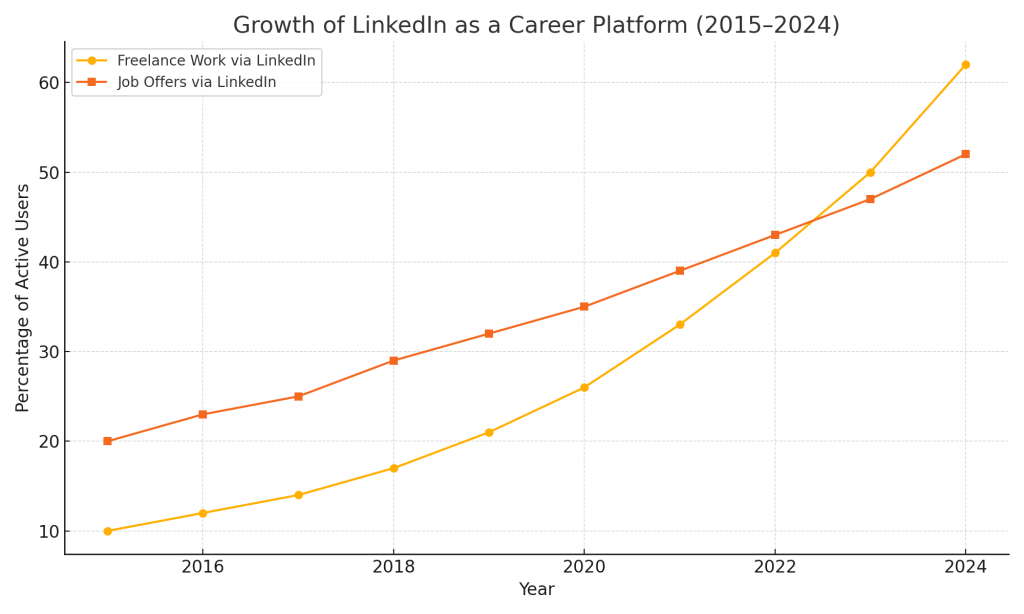The 2026 LinkedIn Playbook: How Real Professionals Turn Content Into Career Opportunities
LinkedIn Can Save Your Job, Or Create One
In 2026, LinkedIn is no longer just a job board or a place to announce promotions.
And whether you’re a LinkedIn lover or hater, LinkedIn is a must for almost every professional. The 26.2B purchased company from Microsoft is no a powerful ecosystem where professionals learn, share, and transform personal growth into public authority.
And for many, that authority translates into freelance contracts, consulting gigs, or full-time roles that didn’t exist just a few years ago.
This shift should NOT be about self-promotion, you risk looking cringy and pushy. It’s about open learning, transparency, and documenting your expertise in a way that resonates with an audience hungry for real insights.

LinkedIn has evolved into a powerful career engine in 2026. By sharing insights, documenting your process, and learning in public, professionals attract job offers, freelance clients, and industry authority. The platform now rewards clarity, authenticity, and micro-teaching—making visibility a key driver of career growth.
1. Why LinkedIn Has Transformed Into a Career-Building Engine
LinkedIn is currently experiencing its biggest transformation since 2020. The post-pandemic wave of online learning, career transitions, and solopreneurship has reshaped the platform. With over 1 billion users, and an algorithm now favoring original content, comments, and micro-teaching, LinkedIn has quietly become one of the most effective platforms for knowledge workers to grow both influence and income.
Let’s look at how.
2. Documenting the Journey
Take Thomas Tsangaras, a LinkedIn Influencer so to speak with 82k followers. He is a career consultant who also helps people with relocation. What an interesting career right? How do you even begin?
Well, he documents his journey !
Instead of waiting until he felt “ready,” he began posting weekly reflections on what he learned, what he thinks, what he sees and experiences in his niche.
- Topics: Clarity in communication, mistakes she made, frameworks that clicked.
- Format: Short posts (200–300 words), often ending with a question. Sometimes with a video.
- Engagement: Grew from a couple hundred to 18,000+ followers in under a year.
Thomas has built a huge audience, industry credibility and receives contracts on a frequent enough basis to start his own company.
With no formal experience, this has happened to many professionals looking to stand out. That is why they had built public proof of learning and thinking. A startup offered a UI/UX designer (a friend of ours) who had done that until around 900 followers. She has a contract role based on her LinkedIn posts alone. She now earns over $80K/year as a freelance UX writer.
“I didn’t market myself—I just showed my process in public. That built trust faster than any resume ever did.”
3. Learning in Public Becomes a Lead Magnet
In Berlin, Tobias Kramer, a mid-career accountant, turned his transition into finance automation into a public resource. His daily content:
- “What I learned about Excel macros today.”
- “Trying to connect QuickBooks with Zapier… here’s what broke.”
- “Why I think no small business should do their books manually in 2026.”
These weren’t viral posts—but they attracted a very specific audience: small businesses and solo founders. Tobias now offers:
- A paid Notion template for freelancers to manage invoices
- 1:1 consulting for accounting workflow automation
- A small email list of 1,500, which feeds his freelance pipeline
All of it started from small, consistent LinkedIn content.
4. Freelancers Using Commentary as Authority
LinkedIn’s algorithm currently favors authentic, non-viral discussion—especially commentary on:
- New industry trends
- Controversial tools (like ChatGPT integrations or data privacy policies)
- First-person case studies
Meena Sharma, a freelance cybersecurity consultant in Singapore, posts weekly breakdowns of recent security breaches—not regurgitated news, but how she would have handled the issue differently. This has led to:
- Guest appearances on niche industry podcasts
- Invitations to speak on panels
- $10K+/month in consulting contracts, mostly inbound
“My posts are like mini job interviews. I just don’t know who’s reading them until they reach out.”

5. Creating Content Funnels from Posts to Services
In 2026, savvy professionals are not just posting for likes. They are creating lightweight funnels using:
- LinkedIn posts → free Notion resources → Calendly consults
- Thought leadership → community building (e.g. Slack groups, private newsletters)
- Case studies → downloadable frameworks → client inquiries
This strategy is increasingly common among:
- Career coaches
- Ops consultants
- Solopreneurs in niche tech fields (e.g., API specialists, data modelers)
Even mid-level employees are building backdoors into career pivots by simply publishing what they’re already doing at work in a distilled format.
6. The Tools and Tactics Professionals Use (2026-Specific)
Superpeer or Ko-fi: For low-barrier coaching or call booking
Shield Analytics: For understanding post performance and engagement depth
AuthoredUp: To pre-schedule and format posts like mini blog entries
Taplio: For AI-powered content suggestions + post drafting
Tally.so or Typeform: To collect leads or offer free consults
7. Best Practices for 2026 LinkedIn Thought Builders
Build “Proof of Thinking”: Show how you approach problems. That’s what future employers or clients will pay for.
Start before you’re an expert: People follow clarity, not status.
Teach one thing at a time: The algorithm favors short, digestible insights.
Engage more than you post: Commenting on relevant industry content is still the fastest way to grow organically.
Final Thought: LinkedIn as a Financial Platform
LinkedIn in 2026 is still about job applications, so don’t replace one for the other but and now it’s time to completement your application strategy with positioning. It’s like inbound marketing but for attracting quality jobs or clients.
By learning in public, reflecting openly, and creating visible signals of competence, professionals are turning content into consulting, thoughts into leads, and insights into income.
Employers now look for candidates who show how they think, not just what they’ve done. When you post insights, reflections, or small case studies, you create visible proof of competence that attracts recruiters, founders, and hiring managers.
Yes—micro-audiences are extremely valuable in 2026. Many professionals get clients, freelance gigs, or interviews from fewer than 1,000 followers. Relevance matters more than reach.
Short insights, practical lessons, transparent reflections, and mini case studies. The algorithm rewards original thinking, not polished “influencer-style” posts. Documenting your process consistently drives trust and inbound opportunities.

